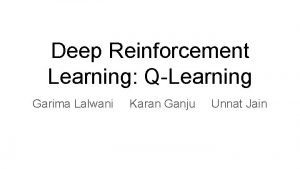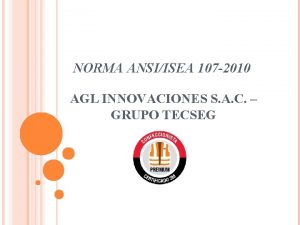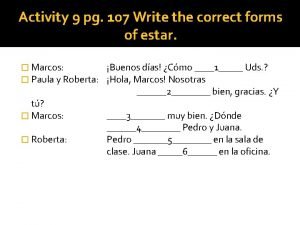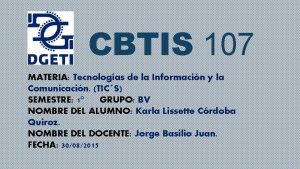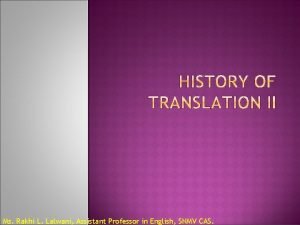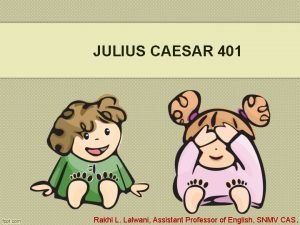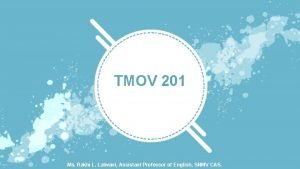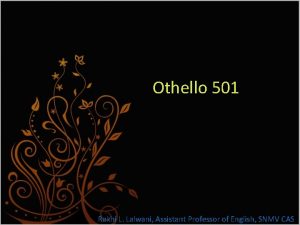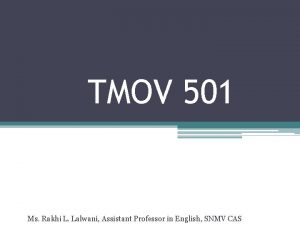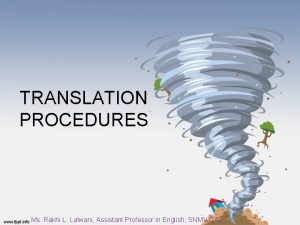QUOTATIONS RM 107 Rakhi L Lalwani Assistant Professor










- Slides: 10

QUOTATIONS RM 107 Rakhi L. Lalwani, Assistant Professor of English, SNMV CAS

Quoting • • Copying of extracts from various sources. Verbatim. Used judiciously and sparingly. Overuse can suggest poor argumentation. Should be relevant. Avoid too many long quotations. Cite appropriately. Rakhi L. Lalwani, Assistant Professor of English, SNMV CAS

When to Quote • Direct Quotations: 1. Original words are very convincing and there can be no improvement on them. 2. For documenting major arguments where footnotes may not suffice. 3. Used for commenting, refuting or analysing ideas of others. 4. When paraphrasing may cause misinterpretations. 5. For citation of mathematical, statistical formulae. 6. Obtain permission to quote if to be published. 7. Ideas should be acknowledged. Rakhi L. Lalwani, Assistant Professor of English, SNMV CAS

How to Quote • Direct Quotations: 1. Exact words with same punctuation, grammar, spelling, capitalisation. Completely accurate. 2. If tenses do not match, interpolations may be added. 3. Permissible to omit sections if too long by using ellipsis, ensuring that the meaning remains unchanged. • Two types: 1. Short quotations. 2. Long quotations. Rakhi L. Lalwani, Assistant Professor of English, SNMV CAS

How to Quote • Short quotations: – – Up to three lines. Incorporate into paragraph. Should not disturb the flow/meaning of the text. Double quotation marks at the beginning and end of the quotation. – Same spacing as text. • Acknowledgement: – With a numbered superscript followed by subsequent footnote. – With a number in square brackets which can later be added in works cited list. – Direct acknowledgement with citation details inclusive of author name and page number in parenthesis followed by a period (full stop). – Refered to as author-date system or the Harvard system Rakhi L. Lalwani, Assistant Professor of English, SNMV CAS

How to Quote • Acknowledgement: – If two authors, names are divided by ‘and’ – If more than two authors, name of the primary author followed by ‘et al. ’ – No punctuation between name of author and page number. – If two works are cited, the name of author and page numbers can be divided with a semi-colon. – If anonymous author, the citation includes the title of the work. – For electronic sources, name of author followed by date. Rakhi L. Lalwani, Assistant Professor of English, SNMV CAS

How to Quote • Long Quotations: – – – More than three lines. Format of acknowledgement remains the same. Indented 0. 5 inches more from the left margin. No quotation marks at the beginning or the end. Ends with proper punctuation followed by citation in parenthesis. • Ellipsis: – To avoid ideas that are irrelevant or to extract important sections or to omit. – Illustrated with three full stops with a space between each. – Should not alter the meaning of the text. – If used before or after full stop, punctuation rules to be followed. Rakhi L. Lalwani, Assistant Professor of English, SNMV CAS

INTERPOLATIONS • When necessary to include additional details, corrections into a quotation. • Should be placed within square brackets and not parenthesis. q Sic: q Used after an error in quotation. q To indicate that the error is also an integral part of the quotation. q Indicates that the researcher realises and is conscious of the error. q Comment: q To clarify a point. q To avoid inaccuracy or error in interpretation. q Supplying an Antecedent q When a non-specific pronoun appears. q Clarification by inclusion of name in square brackets. Rakhi L. Lalwani, Assistant Professor of English, SNMV CAS

SPECIAL QUOTATIONS • Quote within a quote: – For short extracts – whole quotation in double quotation marks and internal quotations within single quotations. – For long quotations – Indented in the normal way without double quotations. Internal quotations are put in double quotes. • Quoting Poetry: – For single line – line enclosed in double quotations and runs into text. – For two lines – slash(/) is used to separate the lines. – Long quotations – rules of indentation for long quotations to be used. • Quoting Speeches: – Avoid inaccuracies or misinterpretation. – Can cite the source in a footnote. • Paraphrasing or Indirect Quotations: – Not enclosed in quotation marks, but acknowledged. Rakhi L. Lalwani, Assistant Professor of English, SNMV CAS

THANK YOU Rakhi L. Lalwani, Assistant Professor of English, SNMV CAS


